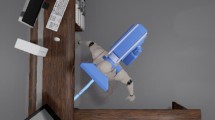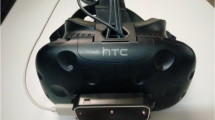Abstract
This paper reports the utility of eye-gaze, voice and manual response in the design of multimodal user interface. A device- and application-independent user interface model (VisualMan) of 3D object selection and manipulation was developed and validated in a prototype interface based on a 3D cube manipulation task. The multimodal inputs are integrated in the prototype interface based on the priority of modalities and interaction context. The implications of the model for virtual reality interface are discussed and a virtual environment using the multimodal user interface model is proposed.
Similar content being viewed by others
References
Apple Computer Inc. Apple Human Interface Guidelines: The Apple Desktop Interface. Addison-Wesley, Massachusetts, 1987.
Begault D R. 3D Sound for Virtual Reality and Multimedia. Academic Press, Boston, 1994.
Bolt R A. The Human Interface: Where People and Computers Meet Lifetime Learning Publications, Belmont, 1984.
Bruner J. Toward a Theory of Instruction. Harvard University Press, Cambridge, 1966.
Burdea G, Coiffet P. Virtual Reality Technology. John Wiley & Sons, New York, 1994.
Dannenberg R B, Blattner M M. Introduction: The trend toward multimedia interface. InMultimedia Interface Design, Blattner M M, Dannenber R B (eds.), Addison-Wesley, Massachusetts, 1992.
Dear D L. HyperCard: What is it?Byte, August 1988, 71–75.
Encarnacao J, Foley J, Bryson S, Feiner S K, Gershon N. Research issues in perception and user interfaces.IEEE Computer Graphics and Applications, March 1994, 67–69.
Foley J D. Interfaces for advanced computing.Scientific American, Oct. 1987, 97–90.
Giagante M A. Virtual reality: Enabling technologies. InVirtual Reality Systems, Earnshaw R A, Gigante M A, Jones H (eds.), London: Academic Press, 1993.
Hauptmann A G, McAvinney P. Gestures with speech for graphic manipulation.International Journal of Man-Machine Studies, 1993, 38: 231–249.
Hill W, Worblewski D, Mccandless T, Cohen R. Architectural qualities and principles for multimodal and multimedia interfaces. InMultimedia Interface Design, Blattner M M, Dannenberg R B (eds.), Massachusetts: Addison-Wesley, 1992.
Kalawsky R S. The Science of Virtual Reality and Virtual Environment. Wokingham: Addison-Wesley, 1993.
Jacob R J K. What you look at is what you get: Eye movement-based interaction techniques. InProc. ACM CHI’90 Human Factors in Computing Systems Conference, 1990, pp. 95–102.
Latta J N, Oberg D J. A conceptual virtual model.IEEE Computer Graphics & Applications, Jan. 1994, 23–29.
Microsoft Corporation. The Windows Interface: An Application Design Guide. Washington: Microsoft Press, 1992.
Pausch R, Grossweiler R. Application-independent object selection from inaccurate multimodal input. InMultimedia Interface Design, Blattner M M, Dannenberg R B (eds.), Massachusetts: Addison-Wesley, 1992.
Robertson P, Earnshaw R A, Thalmann D, Grave M, Gallop J, De Jong E M. Research issues in the foundations of visualization.IEEE Computer Graphics and Applications, March 1994, 73–76.
Rudnicky A I, Hauptmann A G. Multimodal interaction in speech systems. InMultimedia Interface Design, Blattner M M, Dannenberg R B, Massachusetts: Addison-Wesley, 1992.
Wilsson M, Conway A. Enhanced interaction styles for user interfaces.IEEE Computer Graphics & Applications, March 1991, 79–90.
Author information
Authors and Affiliations
Corresponding author
Additional information
This research was supported by the grants from National Natural Science Foundation of China and 863 High-Tech Programme. Part of the paper was first presented at the IEEE International Conference on System, Man and Cybernetics in 1995 at Vancouver, British Columbia, Canada, and at the International Workshop on Virtual Reality and Scientific Visualization in Hangzhou, China, in April 1995.
Wang Jian received his Ph.D. degree in Engineering Psychology at Hangzhou University in 1990. He currently is a professor of psychology and the head of Human Factors Laboratory in Hangzhou University. His research interests include user interface design in VR environment, integration of eye-tracking in user interface design and cognitive process in human-computer interaction.
Rights and permissions
About this article
Cite this article
Wang, J. Integration model of eye-gaze, voice and manual response in multimodal user interface. J. of Comput. Sci. & Technol. 11, 512–518 (1996). https://doi.org/10.1007/BF02947219
Received:
Revised:
Issue Date:
DOI: https://doi.org/10.1007/BF02947219




